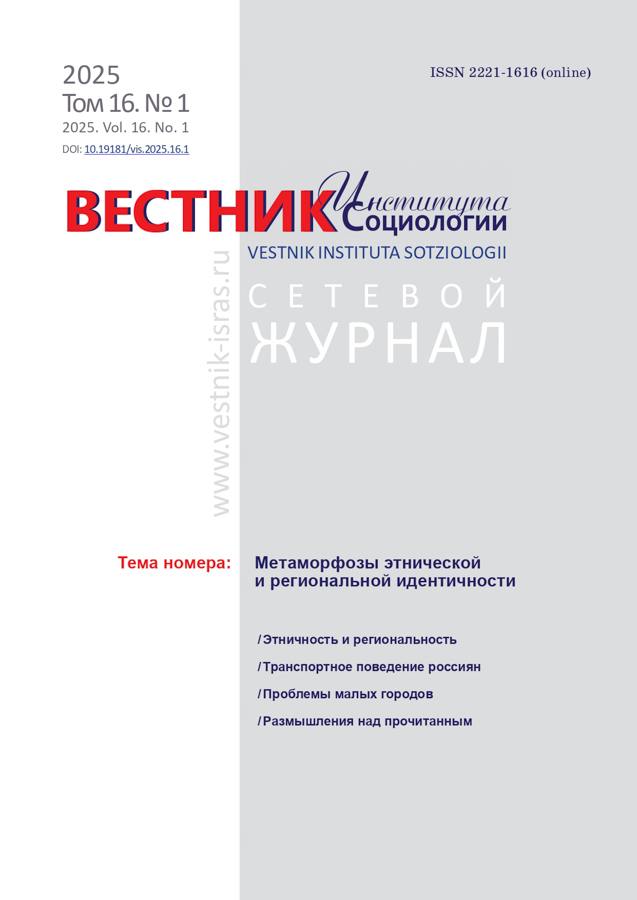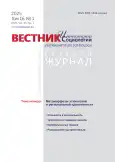Transport behaviour of Russian residents: is it possible to overcome the “cult of the automobile"
- Authors: Makarevich S.K.1
-
Affiliations:
- HSE University
- Issue: Vol 16, No 1 (2025)
- Pages: 137-162
- Section: Car and Russians: peculiarities of transport behavior
- URL: https://journal-vniispk.ru/2221-1616/article/view/289108
- DOI: https://doi.org/10.19181/vis.2025.16.1.8
- EDN: https://elibrary.ru/RPABQV
- ID: 289108
Cite item
Full Text
Abstract
The author assumes that the attitude towards owning a car remains strong and believes that it consists of certain functional and semantic parameters. The author tries to determine the reasons for the rootedness of this attitude and discusses possible ways of its transformation. The results of several waves of the all-Russian omnibus telephone survey "SPUTNIK" VTsIOM (2018-2024) are used as an empirical basis for the study. The survey method is a telephone interview with a stratified random sample extracted from the full list of mobile phone numbers used in the territory of the Russian Federation. The study involved 1,600 Russians aged 18 years and older. The results obtained are based on the analysis of one-dimensional and two-dimensional distributions of features, as well as the calculation and interpretation of the correlation coefficients.
The author comes to the conclusion about the high level of motorisation in the Russian Federation, where the majority of the population has experience of driving and purchasing a personal car, and the number of households without a car is decreasing annually. The use of cars is becoming more intensive, and therefore it is becoming impossible for the majority of Russians to imagine their life without one. Socio-demographic characteristics of individuals only slightly affect their commitment to a car, and the true reasons for the impossibility of giving it up are hidden in the attitude towards car ownership, that consists of the functionality of the car and its semantic images. A car is an integral attribute of life for most citizens, giving them the opportunity to experience a variety of emotions and sensations, as well as maintain the desired level of well-being. The author comes to the conclusion that it is impossible to overcome the “cult of the automobile” in Russia at the current moment.
About the authors
Sofiya K. Makarevich
HSE University
Email: rexbringer12@gmail.com
ORCID iD: 0000-0001-8435-2107
SPIN-code: 1309-6868
Graduate Student, Faculty of Social Sciences Moscow, Russia
References
- Бакаева Э. П. Визуализация идентичности: Символика этнической идентификации в контексте системы автомобильности (на примере Калмыкии) // Сибирские исторические исследования. 2020. № 4. С. 326–364. doi: 10.17223/2312461X/30/15; EDN: YORXIT.
- Веселкова Н. В., Вандышев М. Н. и др. Повседневная мобильность молодежи в небольших уральских городах // Экономическая социология. 2019. Т. 20. № 4. С. 78–113. EDN: WPUFWL.
- Волков В. Н. Автомобили, автомобили, буквально все заполонили // Культурное наследие России. 2015. № 4. С. 9–15. EDN: VJZAXB.
- Кононенко Р. В. Стилевые особенности автомобильного потребления: объективные и субъективные аспекты // Вестник Нижегородского ун-та им. Н. И. Лобачевского. Сер.: Социальные науки. 2010. № 1. С. 27–34. EDN: MTJLCL.
- Крупа Т. А. Региональные аспекты социокультурных проблем автомобилизации городской среды (на материалах Приморского края) // ИСОМ. 2016. № 3-2. С. 111–120. doi: 10.17748/2075-9908-2016-8-3/2-111-120; EDN: WHARMV.
- Медведев А. В., Медведев Р. А. Ограничение использования личного автотранспорта в пользу общественного: мнение россиян // Социология. 2022. № 4. С. 119–127. EDN: KSGWJF.
- Мулеев Е. Ю. «Транспортное поведение», «Подвижность» и «Мобильность»: к вопросу о концептуализации терминов // Социологический журнал. 2015. № 3. C. 8–28. doi: 10.19181/socjour.2015.21.3.2375; EDN: UKAKEP.
- Овруцкий А. В. Потребление как функция культуры // Известия Байкальского госун-та. 2011. № 5. C. 220–225. EDN: OIGINZ.
- Руденко Н. Конкурируя за будущее: проблематизация инновационной автомобильности в публичном дискурсе «Яндекс. Беспилотников» // Laboratorium. 2022. № 2. С. 73–102. doi: 10.25285/2078-1938-2022-14-2-73-101; EDN: PUHWZN.
- Савельева Е. О. Изменение транспортного поведения населения как способ достижения устойчивой мобильности в российских городах // Вестник ПермНИПУ. Прикладная экология. Урбанистика. 2021. Т. 41. № 1. С. 5–18. doi: 10.15593/2409-5125/2021.01.01; EDN: NHPBNB.
- Савельева Е. О. Факторы формирования транспортного поведения в крупнейших городах России // Градостроительство. 2018. Т. 57. № 5. С. 54–62. EDN: IIVGDL.
- Сорокина Н. В., Алипов Д. В. Средство передвижения и статусной мобильности: Машина в социокультурной перспективе // Журнал социологии и социальной антропологии. 2013. Т. 16. № 3. C. 210–215. EDN: RODCHV.
- Урри Д. Мобильности. М.: Праксис, 2012. 576 c.
- Cairns S. et al. Sociological perspectives on travel and mobilities: A review // Transportation Research Part A: Policy and Practice. 2014. No. 63. P. 107–117.
- Carrabine E., Longhurst B. Consuming the Car: Anticipation, Use and Meaning in Contemporary Youth Culture // The Sociological Review. 2002. No. 50(2). P. 181–196. doi: 10.1111/1467-954X.00362.
- Clark W., Wang W. The Automobile, Immigrants, and Poverty: Implications for Immigrant Earnings and Job Access // Urban Geography. 2010. No. 31(4). P. 523–540. doi: 10.2747/0272-3638.31.4.523.
- Cohen M. J. The future of automobile society: a socio-technical transitions perspective // Technology Analysis & Strategic Management. 2012. No. 24(4). P. 377–390. doi: 10.1080/09537325.2012.663962.
- Dant T. The Driver-car // Theory, Culture & Society. 2004. No. 21(4-5). P. 61–79. doi: 10.1177/0263276404046061.
- Deka D. Transit Availability and Automobile Ownership // Journal of Planning Education and Research. 2002. No. 21(3). P. 285–300. doi: 10.1177/0739456X0202100306.
- Gunn S. People and the car: the expansion of automobility in urban Britain, c.1955–70 // Social History. 2013. No. 38(2). P. 220–237. doi: 10.1080/03071022.2013.790139.
- Joo J. The Impact of the Automobile and its Culture in the U.S. // International Area Studies Review. 2007. No. 10(1). P. 39–54. doi: 10.1177/223386590701000103.
- Kent J. Still Feeling the Car – The Role of Comfort in Sustaining Private Car Use // Mobilities. 2015. No. 10(5). P. 726–747. doi: 10.1080/17450101.2014.944400.
- Ong P. Car Ownership and Welfare-to-Work // Journal of Policy Analysis and Management. 2001. Vol. 21. P. 239–252. doi: 10.1002/pam.10025.
- Sheller M., Urry J. The City and the Car // International Journal of Urban and Regional Research. 2000. No. 24(4). P. 737–757. doi: 10.1111/1468-2427.00276.
- Urry J. Inhabiting the Car // The Sociological Review. 2006. No. 54(1). P. 17–31. doi: 10.1111/j.1467-954X.2006.00635.x.
Supplementary files











